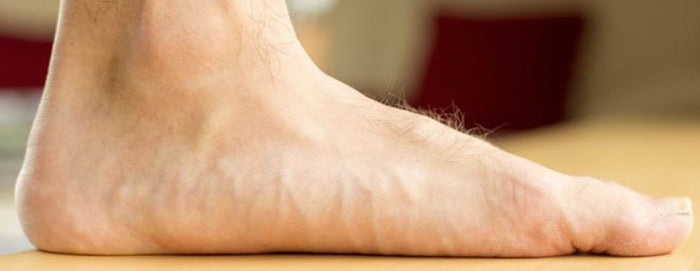
Guide to Neuropathy
Peripheral neuropathy is a nerve dysfunction disorder commonly affecting the feet. Symptoms include tingling, numbness and sharp, burning pain.
In this article, I will be discussing what this condition is, what causes it and how it can be treated. It's more common in older people, especially those past the age of 60, so I will be placing special emphasis on that. This disorder involves nerve problems outside of the brain and spinal cord. This would typically mean your hands, arms, legs and feet. Specific symptoms are related to the kind of nerves affected. There are three major types of peripheral nerves:
Sensory nerves receive and transmit feelings of pain, temperature, touch and pressure. Autonomic ones are involved in basic functions like heart rate, bowel and bladder function and blood pressure. Motor nerves control the muscles. Feelings of numbness or prickling pain in the feet may extend upwards into the legs. You may feel a very sensitive level of touch. For example, just the pressure of your clothing against your skin may cause pain. If your motor nerves are affected, you may experience muscle weakness, falling and paralysis. Numbness from the sensory form can also result in falling. It's difficult to walk properly when you can't feel the surface you are walking on. Autonomic nerve damage can result in excessive sweating, lack of tolerance to heat, dizziness from changes in blood pressure and bladder and bowel control problems. (Healthline)
Causes
Although this condition can affect only one nerve, it most commonly affects several. This is called polyneuropathy. About three to four percent of individuals over the age of 55 have some form of polyneuropathy (WebMD).
Causes include:
- Diabetes
- History of alcohol abuse
- B vitamin deficiency
- Kidney disease
- Thyroid disease
- Chemotherapy
Treatment
Treatment may consist of drugs like pregabalin, gabapentin, certain anti-seizure medications, antidepressants, lidocaine patches and pain relievers like ibuprofen and acetaminophen. For severe pain, opioids may also be prescribed, but these have limited value for pain relief from this condition. Foot pain can be severe, causing insomnia and limited mobility. Sometimes, non-drug therapy can help, too. Foot support products like Select-Flex can help alleviate pain in the feet by adjusting, supporting and improving the arch of the foot. There will be more information about that a bit later in the article.
Problems With The Foot Arch
Flat feet, meaning a poor foot arch, can place extra pressure on foot nerves, causing more irritation and pain. In some people, this is a natural part of the aging process. Tendons, which are tough bands of tissue, connect muscle to bone. It's these tendons, located in the heel, foot and upper leg, that work together to form a correct foot arch (WebMD). When nerves are damaged, they can affect the function of nearby muscles. If you have flat feet, you may notice that your feet tire easily, may feel achy and may be swollen near the inside bottoms. You could have back and leg pain, and it might be difficult to stand on your toes.
A common cause of this condition is Type 2 diabetes, which is more common in older adults past the age of 60 or so. High levels of blood glucose, the result of poorly controlled diabetes, can damage nerves throughout the body, but symptoms are especially common in the nerves of the feet. Additional damage to the feet may occur when you get a cut or a burn you can't feel. Your normal reflex to pull away from the pain of an injury isn't working correctly because you can't feel the initial injury pain. At least 50 percent of people with Type 2 diabetes have some form of foot pain. (Today's Geriatric Medicine)
When medications fail, don't do enough or cannot be tolerated, non-drug therapy may be very helpful, especially as part of elder care. An elderly person with pain in the feet may need additional help to make them more comfortable. This may include:
- Acupuncture
- Physical therapy
- Supportive devices
- Orthotic devices
- TENS
- Massage
TENS, or transcutaneous electrical nerve stimulation, uses electrodes placed on the skin to send a light electrical current to the involved nerves. It's designed to disrupt painful nerve signals before they can reach the brain. Acupuncture uses thin needles that are inserted at certain points on the body. The needles are not painful in themselves. Acupuncture, although not well understood by Western medicine, is thought to relieve pain by inducing the body to release natural substances called endorphins. Endorphins are opiate-like chemicals produced by the brain to elevate mood and relieve pain. They work on the same receptors in the brain that morphine does. Supportive devices like walkers and canes increase security for elder care and may help to alleviate some pain. Proper nutrition and adequate, appropriate exercise is also important.
Intoducing SelectFlex
SelectFlex can increase comfort and reduce pain in the feet by correcting alignment, supporting the arch, providing more ankle support and cushioning the feet. In other words, it can help promote more normal gait and mobility. I invite you to learn more about SelectFlex Arch Control Insoles. We have worked with an orthotics company and our own engineers and product designers to develop a shoe insert that closely imitates the function of certain ligaments in the foot. Our adjustable PowerLift Arch can provide as much as 52 percent more arch support than other inserts at about one-quarter the cost of custom prescription orthotics. You can find out more about us here: (Welcome To SelectFlex) You can also text us at (844) 600-0082. I hope you will want to find out more about how our product can help you with your peripheral neuropathy. On behalf of SelectFlex, we look forward to serving you.
FOLLOW US














